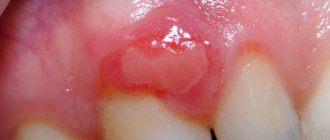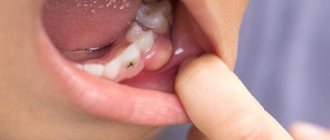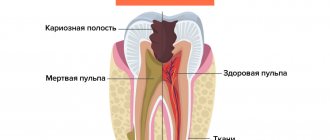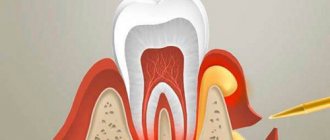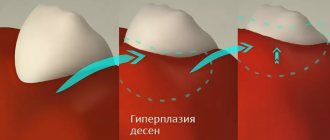Causes
Etymologically, odontoma is associated with anomalies in the development of hard dental tissues. It affects the bone material of premolars and molars and can be localized in both the upper and lower jaws.
Despite the fact that the causes of odontoma are not fully understood, the most significant factors are:
- genetic predisposition;
- specific infections;
- jaw tissue injuries.
The period of maximum activation of the tumor occurs in childhood (from 6 to 11 years), when the main (permanent) teeth begin to erupt, or later, when the third molars erupt. The tumor is detected in most cases somewhat later, about 20 years, and most often it is discovered by chance on an x-ray or due to the development of an inflammatory process in the tumor tissue. Timely diagnosis of odontoma helps prevent the development of complications.
Medical Internet conferences
Relevance. Currently, there is a high incidence of such a tumor disease of the maxillofacial region as odontoma. Its incidence in children is lower than in adults [1]. The reason for this is the slow asymptomatic growth of odontoma. Unlike adults, removal of this tumor in children should be carried out immediately after its diagnosis, since further development of the tumor can lead to consequences such as disruption of the formation and eruption of permanent teeth, displacement of tooth germs, changes in the position of teeth in the dentition, thinning of the cortical plate jaw bones. That is why great attention should be paid to the timely detection of this disease and its monitoring at any age in order to prevent complications.
Purpose: to consider a clinical case of lower jaw odontoma in a 3-year-old child.
Tasks:
1) Analyze the symptoms, clinical picture, methods of examination and treatment of patients with odontoma.
2) To describe a clinical case of lower jaw odontoma in a 3-year-old child.
Materials and methods. A standard examination protocol was used in a pediatric dentistry clinic. Modern sources on this topic were studied, and an analysis of the design of case histories was carried out.
Results and discussions. A benign tumor, built from dental tissue, was first described and named P. Broca odontoma in 1867 [1].
Odontomas make up about 22% of the total number of odontogenic tumors, being one of the most common tumors in this group of neoplasms. There are several ideas about the origin of odontomas. According to some scientists, odontoma is a malformation of one or more tooth germs, consists of epithelium, mesenchyme and their derivatives, and is a mixed odontogenic tumor. According to other data, odontomas are not true neoplastic formations, but rather belong to hamartomas, since mesenchymal and epithelial cells can be found in small quantities in the structure of healthy tissues. The reasons for the formation of odontomas can be the remains of cells of the dental plate, trauma, or a local infectious process. A significant role in the etiology belongs to odontoblastic hyperactivity and changes in the genetic component responsible for the process of dental development [2]. Odontomas can form during the formation of temporary and permanent teeth. As the primary morphological basis from which odontoma is formed, some authors name: 1) epithelial cells of Malasse;
2) tissue of the dental plate, folded into a ball; 3) oral mucosa (this hypothesis is explained by the frequent absence of one or more teeth in the area where odontoma is located); 4) all tissues of normal or supernumerary tooth buds.
There are no differences in occurrence between males and females.
Most often, odontoma occurs among young people, and rarely in old age. According to our observations, odontoma was more common in children during the period of mixed dentition from 6 to 12 years [3, 4]. The reason for visiting a dentist was most often the retention of permanent teeth, less often this neoplasm was an accidental x-ray finding.
Odontoma usually grows slowly; faster tumor growth may be associated with the eruption of the first permanent teeth at the age of 6-11 years or the eruption of third molars. According to our data, odontoma is most often localized in the upper jaw in the area of incisors and canines, less often in the lower jaw, mainly in the area of molars.
Odontoma results from the growth of fully differentiated epithelial and mesenchymal cells and is characterized by slow development and a benign course [5]. It consists of all the components of hard and soft tissues of the tooth: enamel, dentin, cement inclusions, pulp. Neoplasm tissues may have a disorganized structure with a predominance of one tissue over others[6].
The World Health Organization (WHO) classified odontomas in 2005 based on histopathological features into complex and compound. Complex odontomas consist of several teeth, the tissues of which are well differentiated, but arranged randomly. Composite odontoma is represented by small teeth and tooth-like formations that have a certain arrangement [7].
Different types of odontomas are characterized by a number of features. Complex odontoma can grow throughout life; more often detected in adolescence; localized in the area of the molars of the lower jaw; there is no pain or swelling of the jaw; The radiograph reveals a high-intensity, inhomogeneous shadow, which is limited by a thin band of rarefied bone tissue. During the growth process, the tumor can displace tooth germs and formed teeth [8].
A compound odontoma is represented by a combination of several rudimentary tooth germs; interferes with teething; The x-ray shows several small tooth-like formations surrounded by a strip of sparse bone tissue; after excision there are no relapses. Compound odontoma is more common than complex odontoma. After reviewing 104 clinical cases, 67 were diagnosed with compound odontoma and 32 with complex odontoma. It is very rare to find both types of odontomas in one person. Of all those examined, there were only 5 such cases. In the anterior part of the jaws, the majority of odontomas are compound combined (61%), while in the distal part of the jaws complex combined odontomas are more common (34%). Moreover, both types of odontomas are most often located on the right side of the jaw (composite – 62%, complex – 68%) [9].
Odontoma can be hard or soft [10]. Hard odontoma is represented by solid elements of the tooth, pulp and periodontium in various quantitative ratios and combinations. Soft odontoma is the initial stage of the formation of hard odontoma.
A.I. Evdokimov classifies hard odontomas into simple, cystic, complex and complex-mixed forms. In turn, simple odontomas are divided into: 1) complete (tooth-like and rounded in shape) and 2) incomplete (crown, root, periodontomas).
Simple odontomas may involve the joining of tissues from a single tooth germ or consist of a single tooth-like formation. Complete simple odontomas consist of a whole tooth germ; incomplete simple odontomas are represented by a part of a tooth.
Complex mixed odontomas have the appearance of a continuous conglomerate consisting of chaotically mixed hard and soft tissues of the tooth, with separately occurring teeth at different stages of formation [10].
The main method for making the diagnosis of odontoma is x-ray. On an x-ray, a complex odontoma appears as a voluminous, heterogeneous, dense shadow with jagged edges or as small structures resembling teeth. Along the periphery, this formation has a zone of clearing, which passes into limitedly sclerotic bone tissue. Simple complete odontomas produce a round or tooth-like intense shadow on the radiograph. Simple incomplete odontomas appear as an intense shadow of the crown or root part of the tooth, altered in shape and size.
The presence of an inhomogeneous shadow of an odontoma on an x-ray image is explained by the heterogeneity of the histological structure of odontomas (alternation of soft and hard tissues of the tooth).
Cystic odontoma is localized in a follicular cyst, with a characteristic clinical and radiological picture. The only difference from a follicular cyst is that with a cystic odontoma, the cavity of the cyst contains an odontoma, not a tooth [11].
The macroscopic specimen of odontoma can be represented by a formation resembling a deformed or underdeveloped tooth, or complexes consisting of several tooth-like formations. They can easily separate or firmly merge with each other [12].
The most characteristic clinical symptoms of odontoma are the absence of one or more permanent teeth, less often - the absence of temporary teeth, or bone enlargement. The bulge in the jawbone area is usually painless, dense, with an uneven surface [13].
Treatment for odontomas involves removing the tumor along with the connective tissue capsule. After tumor removal, it is advisable to fill the bone cavity with some osteotropic substance [14, 15].
The prognosis is favorable.
Clinical case.
Patient G., 3 years old, came to the Department of Pediatric Dentistry and Orthodontics with complaints, according to her mother, of swelling of the gums in the lower jaw area on the left, which her mother noticed 1 week before going to the doctor. Previous and concomitant diseases: the child is registered with a neurologist (tone disorder syndrome), an ophthalmologist. There was a history of an allergic reaction to Actovegin (urticaria).
The general condition of the child at the time of examination was satisfactory.
The configuration of the face is not changed, regional lymph nodes are without signs of inflammation. The dental formula is age appropriate. The dentition lacks teeth 5.5 and 7.5. In the retromolar region behind tooth 7.4 there is a deformation of the alveolar process, extending to the vestibular surface, with a diameter of 1.5 cm, dense elastic consistency, covered with unchanged mucous membrane, painless on palpation.
After conducting a visual examination, it was not possible to diagnose the disease due to the overlapping of many shadows on each other.
A tomographic examination (CBCT - cone beam computed tomography) was performed (Fig. 1).
CT scan revealed a heterogeneous radiopaque mass surrounded by a thin radiolucent line. The formation is closely related to the germ of tooth 7.5, which is at the stage of root formation. Perforation of the lingual cortical plate was detected (Fig. 1). Interestingly, the absence of tooth germs 1.5, 2.5, 3.5, 4.5 is determined by X-ray, which confirms the relationship of the development of odontoma with a violation of the formation of tooth germs and can indirectly serve as confirmation of the presence of a common etiological factor in their development [16].
A preliminary diagnosis was made: Complex odontoma of the lower jaw on the left. Anomaly in the number of teeth.
A plan of treatment and preventive measures has been drawn up:
1. Removal of odontoma under general anesthesia in a hospital setting.
2. Clinical observation with repeated X-ray control after 1 year.
3. Treatment by an orthodontist.
Treatment was carried out in a hospital setting.
An intraoral approach was created under general anesthesia. The formation was completely enucleated along with the second primary molar. After careful curettage, the wound was packed with iodoform turunda.
Based on the examination of the material - odontoma obtained during the operation (Fig. 2), the diagnosis was clarified: Complex mixed odontoma of the lower jaw.
The turunda was changed once a week for one month. Intraoral healing proceeded without complications. After the intervention, no anesthesia or paresthesia was observed in the areas innervated by the inferior alveolar nerve.
The child was registered at the dispensary. The bone tissue defect was completely restored after 6 months. A repeat computed tomography scan was performed 1 year later. The photographs show complete restoration of the bone structure in the surgical area (Fig. 3).
Further treatment of this child will be carried out by an orthodontist.
Classification of odontomas
There are several types of odontomas:
- soft (at the initial stage it consists of epithelium and connective tissue);
- hard (calcareous deposits from hard dental tissues, most often localized in the corner of the lower jaw, or in the central region of the upper jaw);
- cystic (parts of the tooth germs are located in the cavity of the follicular cyst);
- simple (includes one follicular primordium);
- complex (affects combinations of various tissues and several parts of the teeth);
- composite (filled with tooth-like neoplasms).
Symptoms and course of the disease
Depending on the type of tumor, its symptoms also vary. In the early stage, soft odontoma has similar symptoms to ameloblastoma, but it is characteristic of younger patients.
The tumor grows slowly and then stops developing due to the end of the formation of the dentition. A constant and continuous growth process is observed only in hard complex forms of odontoma. As a result of tumor growth, the bone increases in size, then the cortical plate can be destroyed, and the tumor can penetrate into the periosteum and further.
Despite the fact that the hard type of odontoma is characterized by expansive growth, the development of the pathology remains painless. The first sign is the appearance of a swelling, the surface of which is uneven and lumpy, and feels hard to the touch. Often, during the formation of odontoma, it is accompanied by infection and ulceration of the soft tissues of the oral cavity.
In later stages, odontoma is accompanied by severe inflammatory complications, changes in jaw size, shift and damage to the dentition.
How much does odontoma treatment cost in Israel?
Quality dental care is never cheap, but it should be noted that prices in Israel are significantly lower than in the US, Canada or the UK. How much the treatment program will cost depends on many factors, including the complexity and type of clinical case, the chosen treatment methods, the cost of medications chosen for therapy, the need to attract additional medical experts, etc. The final amount is calculated after completion of the diagnostic examination, but approximate You can find out the cost by leaving your contact information in any of the application forms or ordering a call back. Our medical consultant will contact you, clarify the details and prepare a calculation.
Diagnosis and treatment
To diagnose a tumor, radiography is mandatory; histological examination is used for clarification (during which it becomes clear what the nature of the tumor is).
Treatment of odontoma involves surgical removal of the capsule and tumor tissue, followed by curettage of the tumor bed and sanitation of the intervention area. In severe cases, partial or complete removal of the jaw with subsequent prosthetic replacement is possible.
The earlier the pathology is detected, the less tissue loss is accompanied by surgical intervention, so timely diagnosis in most cases has a favorable outcome. In addition, despite its benign nature, odontoma can also degenerate into a malignant tumor (this phenomenon is observed in 4% of cases).
Regular visits to the doctor and a thorough check of the health of the oral cavity are the key to timely diagnosis of any dental diseases.


